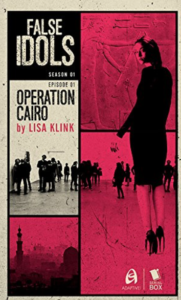Diana Renn
Mysteries that Matter
#RealLifeBackyardRanger Sarah Kollar
Meet Sarah Kollar!

Sarah Kollar is the manager of Ocean Conservancy’s International Coastal Cleanup™ (ICC), the world’s largest single day volunteer effort for our ocean. The ICC started on a single beach in Texas in 1986 and has since mobilized millions of volunteers in more than 150 countries to remove approximately 340 million pounds of trash from beaches and waterways around the world. What makes the ICC so special is its focus on community science: in addition to collecting trash, volunteers log every item they find, helping Ocean Conservancy build the world’s largest marine debris datab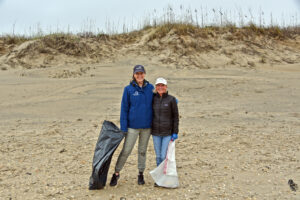 ase. By collecting this data, volunteers help scientists, policymakers, and others better understand the ocean plastic problem and help them to solve it. Sarah has loved marine ecosystems for many years, having grown up along the Great Lakes and now enjoys working with partners all over the world to make coastal -and inland- cleanups for the ICC possible.
ase. By collecting this data, volunteers help scientists, policymakers, and others better understand the ocean plastic problem and help them to solve it. Sarah has loved marine ecosystems for many years, having grown up along the Great Lakes and now enjoys working with partners all over the world to make coastal -and inland- cleanups for the ICC possible.
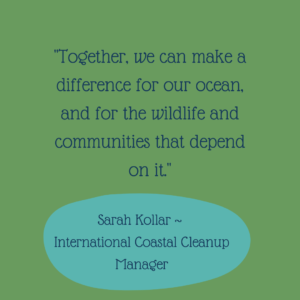

#RealLifeBackyardRanger Tori Fox
Meet our first #RealLifeBackyardRanger, Victoria (Tori) Fox!

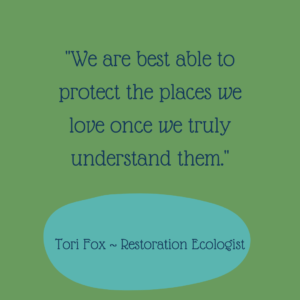 Tori is a restoration ecologist from the coast of the Salish Sea, Washington. She works to fight invasive plants in her community in order to save rare plants and animals from extinction. Victoria recently traveled from Washington to a distant, uninhabited atoll in the middle of the Pacific Ocean, exploring new species of seabirds, reef fish, and tropical plants along the way. On Palmyra Atoll, Victoria and other scientists tackle fields of palm seedlings with their machetes to make space for native forest plants that seabirds prefer for nesting, such as the Pisonia grandis seedling pictured in this photo with Victoria. You can support Tori and her work by visiting the Nature Conservancy and TNC Hawaii and Palmyra.
Tori is a restoration ecologist from the coast of the Salish Sea, Washington. She works to fight invasive plants in her community in order to save rare plants and animals from extinction. Victoria recently traveled from Washington to a distant, uninhabited atoll in the middle of the Pacific Ocean, exploring new species of seabirds, reef fish, and tropical plants along the way. On Palmyra Atoll, Victoria and other scientists tackle fields of palm seedlings with their machetes to make space for native forest plants that seabirds prefer for nesting, such as the Pisonia grandis seedling pictured in this photo with Victoria. You can support Tori and her work by visiting the Nature Conservancy and TNC Hawaii and Palmyra.

Trouble At Turtle Pond comes out in one month!
We are officially one month away from the launch of Trouble at Turtle Pond, out from Fitzroy Books / Regal House on April 5!
 This whole process of researching, writing, selling, and marketing this book has turned me into a conservationist, though I’m still learning how to be one. I don’t have a science background, so it took me awhile to learn that you don’t have to have a Ph.D or really any special training to be a conservationist. Anyone can be one! And lots of creative people can be “creative conservationists,” using their art to raise awareness of creatures that need our help.
This whole process of researching, writing, selling, and marketing this book has turned me into a conservationist, though I’m still learning how to be one. I don’t have a science background, so it took me awhile to learn that you don’t have to have a Ph.D or really any special training to be a conservationist. Anyone can be one! And lots of creative people can be “creative conservationists,” using their art to raise awareness of creatures that need our help.
That’s why I’m launching a series called Real Life Backyard Rangers on the blog and Instagram. It’s inspired by the Backyard Rangers in Trouble at Turtle Pond.
 In Trouble at Turtle Pond, eleven-year-old Miles joins a group of self-appointed young wildlife rangers on his street, who call themselves the “Backyard Rangers.” They live adjacent to a wildlife refuge, but since they can’t always go there without parents, they focus on protecting creatures who occasionally travel outside of the bounds of the refuge and into their neighborhood . . . like nesting Blanding’s turtles, who need some help crossing roads. When they aren’t helping turtles, they run a ranger station out of a cardboard box, sell lemonade to raise money for a field biologist, and educate the public about local wildlife. Their main mission: speaking up for the creatures who cannot speak, and helping people pay attention to – and protect! – these creatures.
In Trouble at Turtle Pond, eleven-year-old Miles joins a group of self-appointed young wildlife rangers on his street, who call themselves the “Backyard Rangers.” They live adjacent to a wildlife refuge, but since they can’t always go there without parents, they focus on protecting creatures who occasionally travel outside of the bounds of the refuge and into their neighborhood . . . like nesting Blanding’s turtles, who need some help crossing roads. When they aren’t helping turtles, they run a ranger station out of a cardboard box, sell lemonade to raise money for a field biologist, and educate the public about local wildlife. Their main mission: speaking up for the creatures who cannot speak, and helping people pay attention to – and protect! – these creatures.
The Rangers are essentially doing community science work even as they investigate a mystery involving the turtles. The more community science work they do – protecting their nests, tracking their whereabouts – the more clues they uncover. The more clues they uncover, the more they commit to their community science and, eventually, their activism.
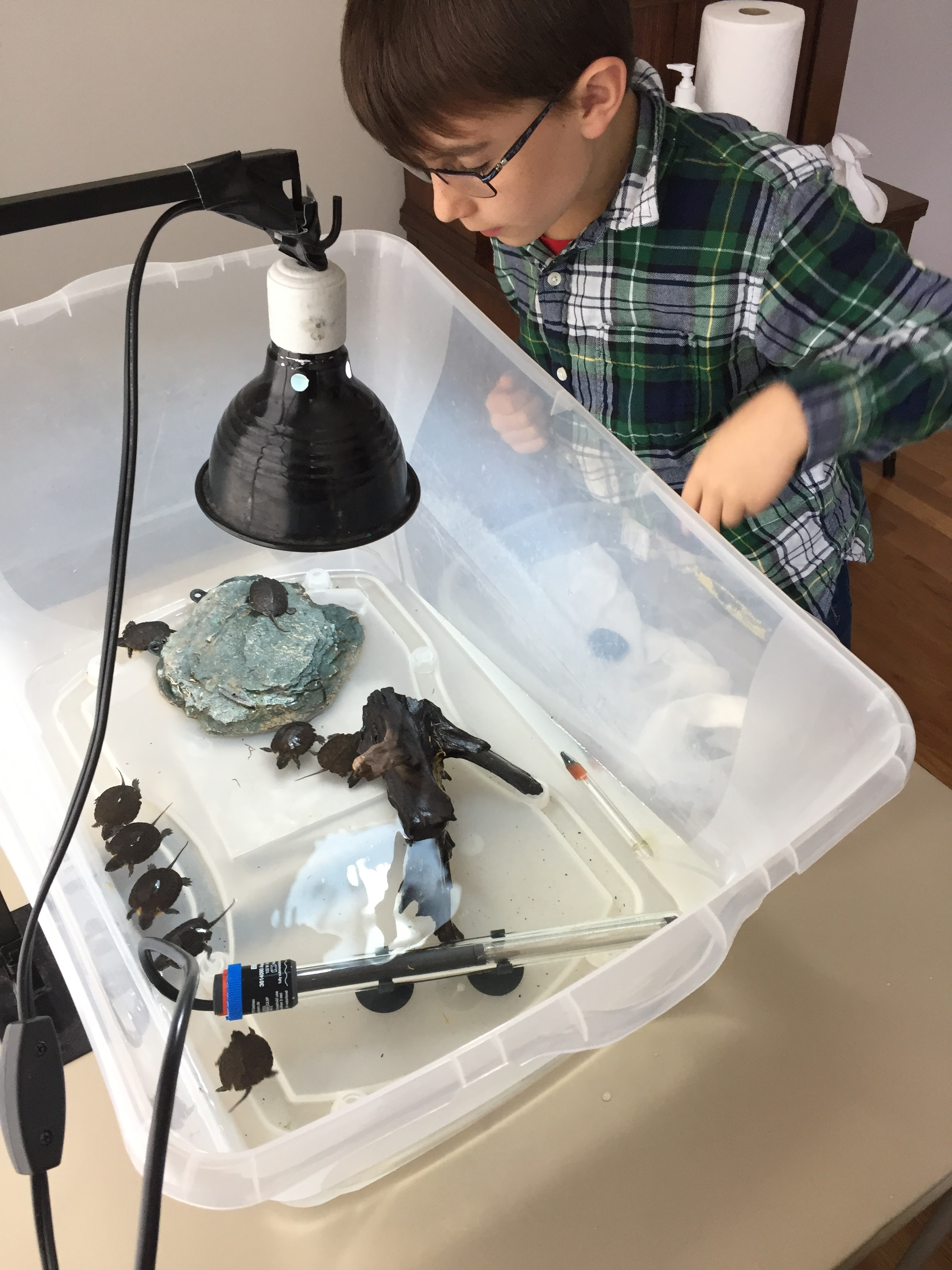
I got inspired to do community science work when my son’s fourth-grade class took care of Blanding’s turtle hatchlings several years ago. My son became deeply interested in them, and this became a family activity even after school ended as we joined a conservation group in tracking turtles to locate nests and protect eggs. We then fostered ten tiny turtle hatchlings in our home for a month. This experience changed our lives. My son went on to give presentations about his community science work, and went on to help other types of animals in other programs. And I wrote a book!
Although my characters are fictitious, I wrote this book in part to make visible the very real work that conservationists do – scientists and non-scientists alike. To celebrate the sometimes invisible work that conservationists and community scientists do, I will be spotlighting a Real Life Backyard Ranger with a photo, bio, and inspiring quote. You’ll learn about these people, all kinds of animals, and organizations all over North America that are helping them.
Here’s a sneak peak of our first Real Life Backyard Ranger, Tori Fox, who works with the Nature Conservancy. Tune in to Instagram next Thursday to learn more about Tori’s work! I hope you enjoy this series, which will post every Thursday, and please feel free to share!

Another important note: a great way to support authors with their launches is by pre-ordering the book, which you can do here. Pre-orders are super important. They help create some buzz around books so that retailers get excited about them and know to stock them in stores. So if you are in a position to pre-order, please know that every book counts, and I really do appreciate it! And if you’re not able, another thing that really helps is requesting that your local library carry the book!
The Five Best Middle Grade Novels Featuring Young Environmentalists
I had a lot of fun putting this list together! A new book browsing website, Shepherd.org, has been reaching out to authors and asking us to participate in the building of this site by creating book recommendation lists on a topic we love, ideally connected to one of our own books. This makes perfect sense to me, since I’m constantly recommending books to people, and I read widely and deeply on topics related to books that I am writing. I have at least a full shelf of books for every novel I’ve published. Strangely, after time passes I sometimes forget things that I wrote in those books, but I remember the novels I read along the way, that offered inspiration and kept me company like friends.
I’ve been reading lots of eco-themed books in the past several years, especially this year as I prepare to launch TROUBLE AT TURTLE POND and am intensely working on a book 2.
I also like how Shepherd book lists are short and give a sense of the writer’s personal connections to these books, as opposed to dry summaries – it feels like meeting up with friends at a cafe and hearing about what they’ve been reading if you only have a few minutes to spare. (Which is one of my favorite kinds of conversations, actually! Hi — how are you – but enough about you, what are you reading??)
My post at Shepherd went live today, and here it is! Click on the link below to find out who I’ve been reading!
https://shepherd.com/best-books/young-environmentalists

Trouble at Turtle Pond Book Trailer!
I’ve always enjoyed making trailers for my books, and I think I had the most fun making this one!
A lot of the images you’ll see are pictures I took myself. Some of the scenery comes from the Great Meadows National Wildlife Refuge in Concord, MA, where a population of endangered Blanding’s turtles (as well as other turtles) reside.
You’ll see a snapping turtle lumbering along a street; she’s actually one of my neighbors. You’ll also see some Blanding’s turtle hatchlings we fostered in our home in partnership with a local wildlife conservation program. You’ll see more turtles than people in this video, as I feel it’s important to see turtles in all their glory to understand why the kids in my novel are so entirely invested in saving them from the various dangers they face. And since endangered Blanding’s turtles reside only in specific areas of North America, I thought it was especially important to let you see them as both hatchlings and adults. (You’ll see one in particular who loves the limelight!)
Trouble at Turtle Pond will be published on April 5, 2022! It’s available for pre-order as an original paperback or in special hardcover edition on the Fitzroy Books / Regal House website, on Bookshop (a healthier alternative to a larger online entity), and, if you’d like a signed copy, my local bookstore, Silver Unicorn Books in Acton, MA.
And so without further ado . . . I’m so excited to share with you the book trailer for Trouble at Turtle Pond! Here it is!
On Becoming a “Creative Conservationist” and Partnering with Creature Conserve
What happens when a non-scientist writes about science?
She might wade through a deep pool of self-doubt and imposter syndrome, for starters. At least I did.
I have always had a strong interest in science, especially environmental science. I enjoyed science classes throughout my education, even if I struggled sometimes, and I really loved the few science classes I took in college. Yet I somehow let myself get steered exclusively toward the Humanities, and into an English major, never really considering how these fields need not be mutually exclusive. I told myself a lot of super unhelpful stories as early as ninth grade: I’m not good at math. You need to be good at math to be good at science. I’m not really a scientist type.
I don’t know where I got the idea that I had to pick one path and stick with it, and why I never let myself fully explore an interest in science, or get the help I might have needed in math to boost my confidence. I graduated from high school just before a big push to get girls into science began.

A Blanding’s turtle hatchling we fostered in our home
Whatever the reason, I continued to tell myself unhelpful stories about my aptitude for science even as I cultivated the idea for my new eco-mystery, Trouble at Turtle Pond, back in 2017. I wanted to write about the turtles my son and I were caring for as part of a conservation program his school had partnered with. I wanted to show the fascinating work that wildlife biologists were doing in the field to bring back our area’s native population of endangered Blanding’s turtles. I would scribble ideas – and scribble them out, telling myself I wasn’t qualified because I wasn’t a biologist, I had no degree in science, I didn’t really know what I was talking about. Or did I?
Eventually the urge to tell the story overcame the fear. And I completed the draft of the book. I decided if I had written outside my comfort zone and immediate knowledge before – which I had done in all my previous novels, writing of places and professions that were not my own — I could do it again. It just felt scarier this time around, because, well, science. As I had with the other books, I sought expert help when I was ready. This time it was in the form of a wildlife biologist, who read the book very carefully and offered incredible feedback. I was surprised how much my research had paid off, how much I’d gotten right. And yes, I’d gotten some things wrong, and was very grateful for his patient corrections! But at no point did he or anyone suggest I was doing the wrong thing by writing about science, and about citizen science sleuths helping a local wildlife biologist to solve some turtle mysteries.
Not only that, when I applied for a mentorship program to get guidance on writing a teachers’ guide and a series of related talks and workshops, my application was selected! I am now a 2021-22 mentee in Creature Conserve‘s mentorship program.
Creature Conserve is an organization founded by Dr. Lucy Spelman, who is a board-certified veterinarian in zoological medicine, a media consultant, a writer, and an educator. The mission of Creature Conserve is to bring artists, creative writers, and scientists together to study, celebrate, and protect animals and their habitats. In addition to this mentorship program I’m participating in, they run a series of professional development workshops for artists, writers and scientists, which you can read about here. The workshops are open to anyone for a fee. I attend my first one yesterday, and came away feeling inspired and empowered to work for conservation as a creative person. Dr. Spelman acknowledged that conservation efforts are lagging partly because scientific literacy is low, scientific information about conservation issues is not always accessible, and people tend to feel either hopeless or intimidated – or trust that “other people” are out there working to save the climate, animals, etc. But we need not be scientists to do conservation work. I learned this is a multifaceted problem that requires an interdisciplinary approach. Artists and writers make important contributions to conservation efforts by helping people to connect to nature, and by raising awareness of the need to protect specific creatures and their habitats. Narrative and imagery are important tools, just as scientific data is an important tool.
I am proud of bringing my turtle book and supporting materials into the world to help do my part as a creative conservationist, and look forward to posting updates here as I progress through the program!
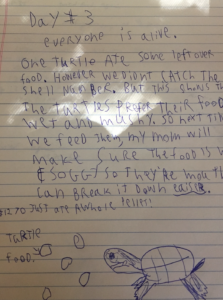
My son’s notes on the hatchlings we fostered; a young citizen scientist in action!
Writing and Weeding
On a trip to see family in Seattle this past August, I visited the National Nordic Museum and stumbled into a special exhibit on landscapes by Finnish painters. I don’t know if it was the luxury of visiting an art gallery for the first time in nearly two years – my soul starved for art not on a screen — or if it was the sheer novelty of an unexpected burst of free time, while my son was occupied with grandparents — but I felt the most extraordinary joy viewing this gallery and taking in every image.
I had no prior familiarity with these Finnish painters (or any Finnish painters, really). The one painting I kept circling back to was called “Wild Anjelica,” by an artist named Akseli Gallen-Kallela (1865-1931). This painting was created in 1889, but the colors seemed so fresh and vibrant, the paint still looked wet, the canvas vibrated with energy.
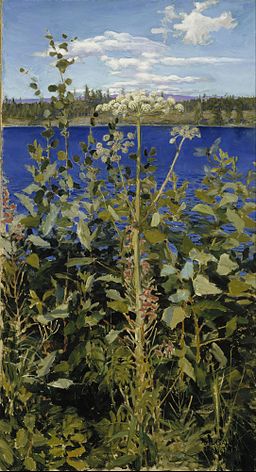
“Wild Anjelica” by Akseli Gallen-Kallela
I have become obsessed with this painting, often gazing at it on screens since my return home. It is a strange image to fixate on in some ways. Its subject is not a grand tree, or a conventionally picturesque flower. Wikipedia generously calls wild anjelica a “species of flowering plant.” But if I didn’t know better, I might call it a WEED. The central image of a rather scrubby-looking blossom, surrounded by prickly neighbors, looks like a plant right out of my own yard, which is tangled with all kinds of weeds that by late summer I typically give up trying to tame. It’s edible, a form of wild celery, and a distant relative of the carrot. But it’s not something I’m dying to sprinkle on a salad.
I think what draws me to this image is its unconventional beauty, and the strength it exudes. I equate Wild Anjelica, and this painting, with these pandemic times. I think of how amidst sickness and suffering and anxiety, we can find beauty in resilience. Like this plant, we twist our lives to find space and light, living in less than perfect conditions. Like this plant, we announce, in defiance: We are here. We are here.
Or maybe this plant and its neighbors are akin to the pandemic. Ugly, dense, no clear way out. Invasive. The alluring blue of water and sky feel like the life we left behind – or the hope of better times to come, on the other side of this virus.
Yet there’s energy and strange beauty in the weeds, just as there are in these times. I reflect on how I have connected creatively with family and friends for over 18 months. I’ve joined my mother on the other side of the country in dance classes online and at the “opera” every Friday night (sung by her neighbor two blocks away, and live-streamed on Facebook). My family acquired a dog. We’ve dined out, on occasion, in parking lots. We’ve tirelessly (or tiredly) Zoomed. I had a milestone birthday, which I feel lucky and privileged to celebrate. We’ve found ways to live creatively, defiantly. Our life probably isn’t the distant water. It’s probably the thicket of weeds.
I like how Gallen-Kallela seems to be playing with us. Are we meant to look at this weedy flower demanding attention in the center of the frame? Or does our eye want to shift to the impossible blue of that water behind it, or up to that expansive sky? The neighboring weeds, too, clamor for attention, insist on being seen and admired, stretching as if to block the water from view.
Sometimes I wonder if the plants in this painting can even be called weeds. They’re not stifling the growth of more carefully cultivated plants. They’re the only plants in the painting.
This painting has also made me appreciate the weeds I’m not pulling in my own yard. I can see them as plants that happen to live in my area, that predate my house and scoff at my landscaping, that have flourished in a summer of heavy rains. I also appreciate the time I’m not spending in battle with them. These days, in my yard, I just live with them. On my walks, I let the wild plants brush my legs. Here are some I pass every morning on my walk with my dog. I’ve come to know and even admire them: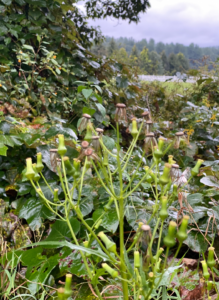
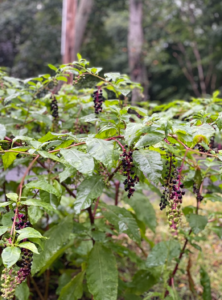
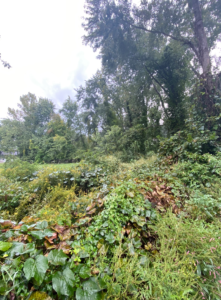
“Wild Anjelica” makes me reflect on my writing process, too. I love the revision stage of writing best because it feels like weeding. The work is hard, sometimes grueling, but satisfying, bringing clarity and lightness. I am a ruthless reviser, cutting out unnecessary scenes and plot lines, or even eliminating characters.
The hardest part of writing for me is shifting from polishing a book to embarking on something new. Tolerating the messiness, the sprawling plot lines and willful characters that threaten to destroy my careful planning, climbing over my path and over the fence rails.
The project I’m working on now has a very new shape for me — it’s a verse novel — and it continually surprises me. New voices clamor to be heard when I thought I had only two narrators. My careful dual timeline structure wants to go in new directions. Backstory creeps in at every turn.
“Wild Anjelica,” and the “weeds” along my walks, are ultimately teaching me patience. I am learning to see the process of drafting, especially in this new-to-me form, not as messiness, but as wildness. I am trying to be more playful, and not worry so much yet about whether some parts are getting in the way of the story, or whether they are the story itself. I am not plotting and planning this project in the same way I have organized my previous novels. Maybe some parts of this particular story are demanding my attention for a reason. Maybe some voices want to be heard. My challenge to myself as I embark on this very early draft is to resist that urge to weed. I will make some space for surprises, and pay attention, as I learn to write — and live — in a new form.
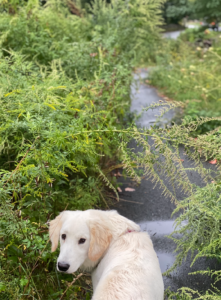
My dog, however, feels a little less happy about the weeds in his path.
New Book Deal!
I’m so, so excited to announce a new book deal — and my first foray into Middle Grade! Fitzroy Books, an imprint of Regal House Publishing, acquired my new mystery, TROUBLE AT TURTLE POND, for publication in Spring 2022. It’s a friendship-centered eco-mystery, about a team of self-appointed young wildlife rangers who try to stop a series of crimes against local endangered turtles – think HOOT meets HELLO, UNIVERSE.
Regal House is a traditional independent publisher putting out a wide range of books for kids, teens, and adults. I’ve been snatching up some of their recent and past titles, reading avidly, and am honored to be in the company of such a talented team of authors and editors. (And they have beautiful covers!) This is an exciting new chapter in my writing career, with a new age group and a new publisher, so I’ll be sharing plenty of news and updates here along the way. Meanwhile, here’s the official deal announcement in Publisher’s Marketplace!

FALSE IDOLS is out!
Well, hello!
It’s been awhile since I’ve posted here – I’ve been a bit busy! (Excuse me a moment while I dust off this blog and throw open some windows!)
So. I spent most of last year working on a brand new book, False Idols. (Hence the lack of blogging). And I’m thrilled to announce, it’s out today!!!
Mass Books Awards Names BLUE VOYAGE a 2016 “Must-Read”!
 Wow – BLUE VOYAGE was selected as a 2016 “Must-Read” for the Commonwealth of Massachusetts! I’m so honored to be in the company of these amazing authors. Congratulations to all Massachusetts Book Awards winners and honorees! Do check out all the great reads across categories on their poster, which will be distributed to libraries throughout the state. (Blue Voyage is listed on the right sidebar, second from the bottom).
Wow – BLUE VOYAGE was selected as a 2016 “Must-Read” for the Commonwealth of Massachusetts! I’m so honored to be in the company of these amazing authors. Congratulations to all Massachusetts Book Awards winners and honorees! Do check out all the great reads across categories on their poster, which will be distributed to libraries throughout the state. (Blue Voyage is listed on the right sidebar, second from the bottom).
Diana Renn Author | Website Content Copyright © 2024 | Privacy Policy
